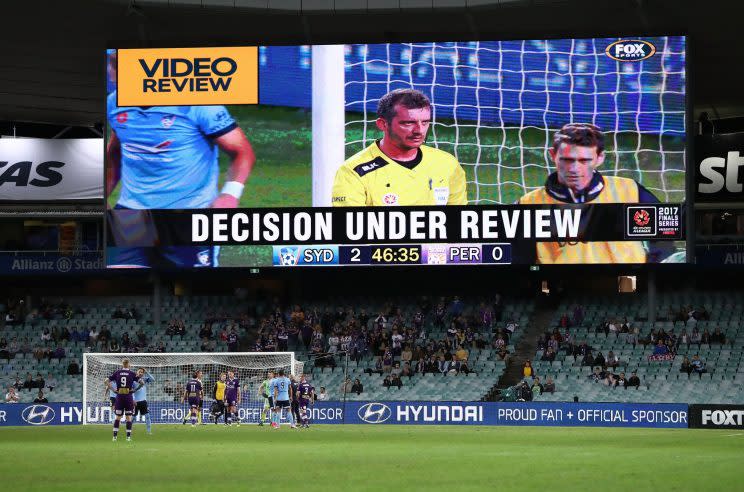VAR: How football's video review system already needs vast improvement

The A League is the first domestic league to try out the VAR (video assistant referee) system, but at the moment it appears as if they have been given a carte blanche without guidelines.
As the dust settled on Sydney FC’s 3-0 win over Perth Glory at the Allianz Stadium, the visitors will have every right to feel aggrieved.
The hosts were already a goal to the good before two reviews were made, but it served as yet another reminder of why the system already needs serious fine-tuning.
The problem was that in both the two incidents, which you can watch above, the decisions actually raise more problems than they solve.
For Jordy Buijs’ goal, the linesman initially flagged for interference for an offside party. Which seemed odd given Buijs made his run from deep. On review, bizarrely, the linesman’s decision was overruled when actually the replay seemed to justify it.
For the second, and Sydney’s third, Filip Holosko’s header was wrongly flagged offside. The referee went upstairs, and it was overturned. Seems legitimate, right?
Only the referee didn’t immediately go upstairs, and astonishingly the replay was shown on the screens in the ground – when it became evident within seconds the wrong decision was made – before the referee brought his assistant into play.
The scenes were so comical it was a farce, and what happened perilously treaded the line of cheating.
READ MORE: Video replays make debut as Sydney draw in Wellington
FIFA president Gianni Infantino only last week revealed that the 2018 World Cup was set to host VAR officials. The system must be refined by then or risk farce on the biggest stage possible.
The system can provide a much brighter future for football, but it needs to be tweaked sooner rather than later to minimise controversy.
Give VAR officials microphones
This suggestion has been one bandied about in football for a while, but it seems prevalent now more than ever.
In Sydney’s first use of the VAR, it was questionable whether the official considered the intention of the handball incident, rather than just seeing ball hit hand and concluding it was a penalty.
This time around, there was a positive – the broadcasters were told, via the officials supposedly, that the upstairs referee thought the offside interference for Buijs’ strike was minimal.
Well, it was probably the wrong decision but being told of the reasons behind the decision added to the transparency of it.
Impose a time limit on officials
In cricket, players are given 10 seconds to decide whether to use the Decision Review System (DRS) to make a review.
VAR is entirely separate, but the referee must make his mind up within a set amount of time.
When Sydney were in Wellington, the visitors got all the way down the other end of the pitch before the official went upstairs to penalise a handball. A good 30 seconds passed.
In their clash against Perth, for Holosko’s header, the referee delayed for long enough that replays were shown on the TV screens. I’ll get to that particular problem later, but there’s surely no way that can be permitted.
Referees need to be decisive, and imposing a window in which the referee can go upstairs will seriously help to mitigate some of the controversies we have already witnessed.
Officials might opt to take the safe option under these circumstances, and review more than not, but given the restrictions on what referees can take another look at, what is the harm?
Let the captains refer to the VAR
Another method of dealing with the controversy of the VAR is to let the captains of each side opt to go upstairs, again emulating cricket rather than rugby.
Give them a review each, make them count. That way the onus is on the players to work out whether they have a valid appeal.
Admittedly, this would require a lot more maintenance than the other suggestions, but it could absolve the officials of at least some of the heat.
Ban TV highlights until an ‘incident’ has ended
Let’s call an ‘incident’ the moment a foul has been called or a goal has been disallowed, and let’s say it runs until the end of the referee’s timespan for review.
In-ground highlights in the A League have not been under the same guiding principles as you may see in England. TV screens will often show goal incidents, regardless of controversy.
Obviously, what happened in Sydney on Saturday was a complete farce, for one very simple reason.
If we are not to go down the DRS route of letting players decide their review, then the onus categorically is on the referee to decide whether to go upstairs or not.
No justification in the world can adequately explain how the official was allowed to see the incident on the stadium screen before opting to go upstairs.
Fans will moan, players will protest in efforts to sway the officials. But we cannot permit the crowd, or the home club, to so obviously sway the decision of the referee, otherwise, why even have the middle man?
Yesterday’s incident was unsavoury, but there’s no element of blame on Sydney. What happened was down to a lack of understanding, and a serious failure of guidelines to help implement a new form of officiating into the game.


